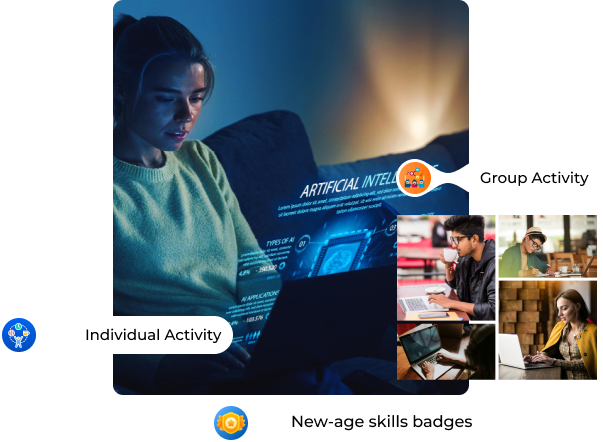SIMD
Take Charge of Your Learning
Take full control of your learning journey with guided self-awareness, reflection, and goal-setting strategies.

Discover the best learning methods tailored to your Learning Style, Goals, Language Proficiency, Difficulty Level and Subject Content.

Anytime, Anywhere, Any subject
This user manual is your step-by-step guide to navigating YMetaconnect, designed to help learners, mentors, and institutions achieve better outcomes.
From setting up your learning dashboard to tracking progress using RAR and SIMD tools, this guide will walk you through everything you need to make the most of YMetaconnect’s personalized learning environment.
Download Brochure


Students, professionals, and individuals can prepare for school, university, and competitive exams, explore job and placement opportunities, connect with peers, and reflect on their growth.


Teachers, professionals, and trainers can design engaging learning content, track learner progress, connect with a global audience, and earn rewards based on the success of their courses.


Companies, universities, schools and institutions can engage with emerging talent, support learning initiatives, and identify skilled individuals for collaboration, internships, or job opportunities to learners.
We enhance self-regulation through the R-A-R AI Tool™ and the Self-Instructional Metacognitive Developer™, empowering deeper learning and fostering new-age skills that give learners a true competitive advantage.

Implementing student-driven learning through the RAR framework to enhance academic performance, competitive exam success, and human-centric skill
Learn More

Personalized & Interactive learning Active Learning & Engagement Collaborative Learning Critical thinking and Problem Solving Metacognition & Self-Regulated Learning
Learn More
Follow customized learning paths that suit your pace and style. The platform adapts to your strengths and gaps using AI tools for deeper subject understanding.
Use R-A-R AI tools and the SIMD method to review, act, and reflect on what you've learned. Prepare for competitive and school exams with confidence and strategy.
Gain digital certificates, skills badges, and learning rewards as you progress. Build study habits, critical thinking, and self-regulated learning skills to achieve your goals.
Easily monitor each learner's journey using SIMD insights and R-A-R reflections. Provide meaningful guidance based on real-time learner data.
Save time with automated feedback and self-assessment tools. Focus more on mentoring and less on admin work.
Receive digital certifications, and opportunities for professional development. Join our mentor community and grow your educational impact.
Deliver better learning outcomes with personalized, AI-powered tools that help students build real-world, in-demand skills. YMetaconnect supports structured learning, reflection, and continuous growth for future-ready graduates.
Equip learners with employability skills like critical thinking, communication, and self-regulation. With targeted training and assessment tools, students become placement-ready and attractive to top recruiters.
Offer a future-ready learning environment that attracts more students and builds your institution's reputation with industry partners. Better student outcomes and successful placements elevate your brand value among employers.




I recently used the beta version of YMetaconnect, and it has been an amazing experience. The
tools are very easy to use and truly support the way I plan and guide my sessions. What
stood out most is how well the platform follows student-centered learning principles. It
encourages students to take charge of their progress while allowing me to support them more
meaningfully. YMetaconnect makes it easier to develop essential skills like innovation,
leadership, motivation and critical thinking in learners. It’s been helpful not just for my
mentoring but also for creating a more engaging and personalized learning journey for
students.
Dr. Vidhya Pillai, Associate Professor and MBA Program Head, Bangalore

YMetaconnect completely changed the way I study. I used to feel overwhelmed
before exams, but
with the RAR method and daily tracking tools, I became more organized and confident. The
Review–Action–Reflection routine helped me understand my weak areas and improve step by
step. Now, I’ve cracked my entrance exams and am applying to the top 20 colleges in the
world. YMetaconnect made me believe it’s possible!
– Advait Krishna, Singapore

YMetaconnect has really helped me grow in my job. It made it easy for me to work on
important
skills like communication and critical thinking. The tools are simple to use, and I like
how
it helps me think about what I’m learning. It’s a great platform to improve skills that
matter at work.
– Mukul Gupta, Bussiness Analyts, Jaipur

YMetaconnect changed how I approach studying. Using the RAR method helped me realize where I was going wrong and how to fix it. I don’t just memorize anymore, I actually understand what I’m learning.
Read more
As a mentor, YMetaconnect made it easier to guide students through structured reflection. The Review-Action-Reflection format gives students ownership of their learning and I can clearly see their progress over time.
Read more
Before this platform, I never thought about how I think. Now, through self-assessment tools and journaling, I know how to study smarter, not harder. My grades and confidence both improved!
Read more
The built-in metacognitive tools are brilliant. I’ve used many learning platforms, but YMetaConnect uniquely blends reflection with goal tracking. It’s a game-changer for fostering real growth in students.
Read more
YMetaconnect encourages students to ask the right questions, not just find answers. Watching them evolve into self-directed learners has been the most rewarding part of mentoring here.
Read more
I'm truly impressed by YMetaconnect. It's a thoughtfully designed platform that empowers learners and supports mentors in meaningful ways. It’s exactly what students need to prepare for the future. With a strong focus on 21st-century skills, it helps build confident, capable, and future-ready individuals. Highly recommended!
Read more
If you’re running a school, training program, or workplace learning initiative, chances are you’ve asked this question: Should I use a free LMS or pay for one? At first, free platforms look like the obvious choice. They let you upload content and start online learning without any cost. But when more learners join or when you need advanced features, you may run into limits. Paid platforms, on the other hand, promise powerful tools and long-term value, but they require budget planning. This blog will give you a clear picture of free LMS vs paid LMS features. We’ll explain the pros and cons of free vs paid LMS, highlight the benefits, and help you understand which option fits your requirements. What is an LMS? An LMS is a software platform that helps deliver, manage, and track learning online. It works like a digital classroom or training center where learners, teachers, and organizations can share resources and measure progress. A traditional LMS platform typically focuses on basic course delivery and administrative tasks. However, the strength of an LMS depends on its features. Common LMS features include: Content management for courses and files Assessment tools for quizzes and assignments Tracking and reporting systems User management for learners and mentors Integration with third-party apps and tools When comparing free LMS vs paid LMS features, it’s important to remember that not all platforms are built the same. The range and quality of features directly impact how well learners engage and how much value organizations gain. What Is a Free Learning Management System? A free Learning Management System (LMS) is software that helps teachers, trainers, and organizations deliver courses online without paying a license fee. These platforms usually include the most basic tools needed to get started with digital learning. Some common free LMS features are: Uploading simple courses, videos, or documents Creating basic quizzes and assignments Offering limited discussion boards or forums Tracking learner progress in a very general way Free LMS options are attractive because they remove the upfront cost. They allow schools, nonprofits, or small businesses to experiment with online learning before investing money in a full solution. However, these systems come with important limits that can affect long-term use. To better understand them, let’s look at the pros and cons of free vs paid LMS, starting with free platforms. 1. Pros of Free LMS The advantages of free LMS include: No licensing fee: Great for small budgets, free tools allow anyone to begin teaching online without added costs. Quick setup: Many free LMS platforms are easy to install and let organizations try online learning right away. Useful for small groups: For a class, club, or pilot project with a limited number of learners, a free LMS can do the job well. 2. Cons of Free LMS Let’s find out the disadvantages that are associated with free LMS. Limited customization: Most free platforms don’t allow full control over branding or design, which can make courses look less professional. Weak support: Technical issues are usually solved through community forums, which may take time and lack reliability. Basic reporting: Free systems rarely provide advanced analytics, making it difficult to measure how learners are progressing. For small-scale programs, free LMS platforms can work well. But when organizations grow or require advanced tools, the limitations become roadblocks, pushing them to consider paid options. What Is a Paid Learning Management System? A paid Learning Management System (LMS) is designed for schools, universities, and companies that need reliable and scalable learning platforms. Unlike free tools, paid options come with advanced tools, professional support, and strong security that make them suitable for long-term and large-scale use. Some common paid LMS features include: AI-driven personalization that adjusts lessons to each learner Rich analytics and detailed progress reports Mobile-friendly design for anytime learning Gamification, badges, and interactive tools Secure storage and compliance with data laws These features make paid LMS platforms a strong choice for organizations that want to create engaging, safe, and flexible learning experiences. 1. Pros of Paid LMS The benefits of paid LMS are as follows: Consistency and reliability: Paid platforms are built to handle everyday use at scale. Updates are regular, and crashes are rare. Advanced tracking: Beyond recording course completions, paid LMS platforms provide insights into learner performance, engagement, and knowledge gaps. Professional support: Dedicated support teams are available to solve problems quickly, ensuring that technical issues don’t disrupt learning. 2. Cons of Paid LMS Let’s look at the disadvantages mentioned below: Higher cost: Paid systems require licensing fees or subscriptions, which can be challenging for very small teams or startups. Setup and training time: With more features comes a longer learning curve. Teams may need extra time and training to use the platform effectively. Ongoing commitment: Unlike free systems that can be abandoned easily, paid LMS platforms require ongoing investment and planning. Free LMS vs Paid LMS Features: A Clear Comparison Here’s a quick comparison to show the differences: Features Free LMS Paid LMS Content hosting Basic uploads Advanced multimedia, large storage Personalization Very limited AI-driven, learner-specific paths Assessment tools Simple quizzes Advanced exams and assignments Analytics & reporting Minimal Detailed insights, progress dashboards Integrations Few or none Wide integration with tools and apps Support Community-based help Dedicated 24/7 support Security & compliance Basic Advanced security, GDPR, ISO compliance Scalability Low High scalability for large organizations How to Choose the Right LMS for Your Requirements? Choosing the right LMS in 2025 is essential. Here are some simple steps to decide the right LMS for your requirements: Define your goals: Are you training employees, teaching students, or running skill-based programs? List must-have LMS features: Identify what matters most—personalization, analytics, or integrations. Compare free LMS vs paid LMS features: Look at short-term and long-term value, not just cost. Check scalability: Choose a platform that grows with you. Look for support and security: These are crucial for data protection and smooth operation. Introducing YMetaconnect: A Smarter LMS Choice When comparing free LMS vs paid LMS features, many organizations struggle to find a platform that offers both advanced tools and personalized learning. This is where YMetaconnect stands out. It’s not just an LMS; it’s an AI-powered learning platform that goes beyond the basics, helping schools, universities, and organizations move past simple course delivery. With YMetaconnect, you get: Personalized learning powered by AI, adapting to each learner’s pace, style, and goals. Collaborative tools for learners and mentors, including discussion boards, group tasks, and feedback loops. Structured learning strategies through the SIMD tool and the RAR AI tool build critical thinking, reflection, and problem-solving skills. Secure and scalable systems, ensuring data protection and seamless growth for your organization. A learner-first design that develops modern skills such as communication, leadership, adaptability, and ethical decision-making. Also, to make advanced learning accessible, YMetaconnect offers flexible plans for every learner. These plans include the Foundation Plan (free), the Advanced Plan, and the Expert Plan, which provide access to SIMD, community forums, RAR tools, certificates, and many more. Each plan is designed in such a way that it supports learners at different stages. By combining the features of LMS with AI guidance and metacognitive tools, it transforms learning into an active, engaging, and future-ready experience. Final Thoughts The choice between free and paid LMS depends on your requirements and your vision for the future. Free platforms are useful for small-scale or short-term use. But their limits in features, support, and security often make them less effective over time. Paid LMS platforms provide advanced LMS features, professional support, and the ability to scale smoothly. The pros and cons of free vs paid LMS make one thing clear: the benefits of using a paid LMS far outweigh the costs when learning is a serious goal. If you’re ready to move beyond the basics, YMetaconnect offers the balance of innovation and reliability needed to succeed. With its smart tools and learner-focused design, it is more than an LMS; it’s a platform for growth.


Education is changing. Today's classrooms are not solely about a teacher delivering a lecture while everyone else listens. Instead, schools and colleges are working towards student centered learning, where students participate actively as part of the learning process. In a student-centered approach, students become good at asking questions, exploring, reflecting, and making connections through the lessons in their own lives. A teacher becomes a guide instead of merely dispensing knowledge. This shift lies at the core of modern education to prepare students for not only success in examinations but also to develop the skills they need for real life. Students who are more engaged and accountable for their own learning process will become more confident and adaptable. In this blog, we’ll share 15 top tips for student centered learning success. These classroom strategies will improve student engagement, make lessons more interactive, and create a strong base for effective teaching. What is Student Centered Learning? It is an approach where learners are active participants. Instead of passively listening, they question, discuss, reflect, and apply what they learn. Teachers act as guides who design classroom strategies that encourage thinking, collaboration, and real-world application. Unlike traditional methods that focus only on memorization, learner centered education helps students build independence and critical thinking. It is effective because it supports different learning styles and gives every learner a chance to succeed. This method has become important in modern education, where the goal is not just passing exams but preparing for future challenges. 15 Practical Tips to Make Learning Better If you’re looking for simple and practical ways to bring learner centered education into your classroom, here are 15 top tips for student centered learning success. 1. Start lessons with student questions Instead of beginning with a lecture, ask students what they already know or what they want to explore. This shows them that their thoughts matter and sets the tone for active participation. Even a simple “What do you think about this topic?” can spark curiosity. 2. Use group work and peer learning Learning doesn’t always have to come from the teacher. When students work in small groups, they exchange ideas, explain concepts in their own words, and support one another. Peer learning among students makes the classroom feel more like a community than a one-way street. 3. Allow choice in assignments Not every student learns the same way. Some love writing essays, others may enjoy creating a video or a poster. By offering choices in how assignments are completed, you give learners freedom while keeping the goals the same. Choice motivates students to put more effort into their work. 4. Connect topics to real-life situations Abstract lessons can feel distant if they don’t connect to everyday life. Use examples from current events, community issues, or even daily routines. When students see how topics matter outside of school, learning for them becomes more meaningful and memorable. 5. Encourage reflection journals Encourage learners to keep a simple journal where they write about what they understood, what confused them, and what they want to explore further. Reflection is powerful; it turns learning into a habit and helps students track their growth over time. 6. Use technology and digital tools smartly Technology can bring lessons alive. From videos and online quizzes to collaboration apps, digital tools support different learning styles. Used wisely, they make modern education more engaging and interactive, while still keeping the focus on learning. 7. Focus on project-based learning Projects allow students to take knowledge and apply it in creative ways. A science project, a history role play, or even a community survey lets them practice teamwork, problem-solving, and creativity. Projects also give learners a sense of ownership over their work. 8. Create flexible seating and open spaces A classroom with only rows of desks can feel rigid. Try arranging chairs in circles, group tables, or even creating quiet corners for individual work. Flexible seating encourages collaboration and shows students that the classroom is their space too. 9. Apply the Review-Action-Reflection cycle Learning is stronger when it follows a rhythm. Start with a short review of what was covered, let students practice through an activity, and then end with a reflection. This review-action-reflection cycle helps learners remember more and apply it better. 10. Offer continuous feedback instead of one-time grades Grades alone don’t guide improvement. Instead, give small pieces of feedback during the learning process. A quick comment, a suggestion, or a question can encourage learners to adjust and grow step by step. 11. Blend assessments with activities Instead of waiting for a final test, mix assessment into everyday lessons. Use games, quick quizzes, or role plays that feel less stressful but still show how well students are learning. Blended assessments make evaluation feel natural, not forced. 12. Encourage student-led presentations Hand over the stage and let students present topics in their own style. Presenting helps them organize ideas, build confidence, and practice communication skills. It also gives the class a fresh perspective, since students explain in their own words. 13. Use problem-solving activities Give students real-world problems to solve together. Whether it’s a math puzzle, a science challenge, or a social issue, problem-solving tasks encourage critical thinking and teamwork. These are exactly the skills learners need beyond school. 14. Support multiple learning styles Every learner is different. Some need visuals, others learn by reading, and some prefer hands-on activities. By mixing methods like discussions, experiments, charts, or stories, you show students that their way of learning matters. 15. Build a safe and inclusive classroom environment Above all, create a classroom where every student feels valued and respected. When learners know they can share without fear of judgment, they open up, ask questions, and participate fully. A safe environment is the foundation of effective teaching. Where YMetaconnect Fits In? Bringing all of these ideas into daily teaching can feel challenging without the right tools. This is where YMetaconnect makes a difference. YMetaconnect is an AI-powered learning platform designed to promote learning in simple, structured ways. It gives learners and mentors tools to plan, act, and reflect. Also, it achieves Student-Centered Learning Principles, which are as follows: 1. AI-Powered Personalized Learning – At YMetaconnect, students can upload their own content, and its intelligent system recommends methods, examples, and questions personalized to their style, goals, selected difficulty level, and English proficiency. 2. Active Learning & Engagement – It uses hands-on tasks and real-world simulations to ensure students build knowledge actively, leading to deeper understanding and longer retention. 3. Collaborative Learning Ecosystem – The platform enables meaningful peer interactions through group projects and discussions that promote teamwork and communication, preparing learners for real-world environments. 4. Critical Thinking & Problem Solving – It challenges students through progressively complex challenges that strengthen reasoning, creativity, and confidence. 5. Metacognitive Development (SIMD & RAR) – The SIMD tool empowers students to take charge of their learning through self-guided instruction and reflection. Paired with the RAR framework, it helps them plan, track progress, and optimize their learning journey. Note: New-Age Skill Development Tracker: Monitors skills like communication, problem solving, leadership, and adaptability. For learners, it builds confidence and self-awareness. For mentors, it reduces manual work and gives clear insights. For institutions, it ensures both academic success and future-ready skills. With YMetaconnect, every requirement of learners, mentors, and organizations is met in one platform. Conclusion The future of education depends on how well we can adapt to the changes. By using the tips for student centered learning success, classrooms can become more engaging, flexible, and effective. Learners not only remember better but also grow skills that matter in life and work. When combined with tools like YMetaconnect, this approach becomes easier to apply. The platform supports both the process and the outcome of learner centered education, ensuring lasting success in education. If you want to build active classrooms, improve student engagement, and practice effective teaching, start small with these strategies. Over time, you’ll see how this approach can transform not just lessons but the entire learning journey.


Imagine a classroom where students don’t just memorize facts but solve real-life problems. This is what Problem Based Learning (PBL) does. Students explore questions, work together, and think for themselves. Instead of sitting and listening, they try to solve challenges that feel real. PBL, along with good student learning strategies, helps students take charge of their learning. Collaborative learning lets them share ideas and work as a team. By using real projects and activities, PBL helps students practice skills they will need in the future. It makes learning interesting, useful, and fun. Let’s understand more about it in this blog and explore the strategies for its success. What is Problem Based Learning? Problem Based Learning (PBL) is when students learn by solving real-world problems instead of just reading or memorizing. They look at a problem, discuss it, find ways to solve it, and reflect on what they learned. PBL helps students see how knowledge connects to real life, not just textbooks. It encourages them to ask questions, explore different ideas, and think critically. Working in groups allows learners to share their perspectives and learn from each other. Over time, students become more confident, independent, and better prepared to tackle challenges both in school and beyond. 1. Benefits of Problem Based Learning The benefits of PBL are as follows: Think Better: Students learn to see different solutions and think creatively. Stay Interested: Learning is more fun when it relates to real life. Remember More: Using knowledge in practice helps students remember it longer. Learn Skills: PBL helps students communicate, work in teams, and solve problems. Reflect and Learn: Students think about what they did and how they can improve. It changes classrooms from boring to active ones. Students practice real skills and get ready for challenges in life, not just school. Examples of Problem Based Learning Activities Here are some practical examples of problem based learning activities that teachers can use to make learning active and meaningful. 1. Environmental Projects Students can explore local environmental issues, such as pollution, waste management, or water conservation. They research the problem, discuss possible solutions in groups, and suggest practical actions. For example, they might create a plan to reduce plastic use in their school or neighborhood. This activity helps students develop learning strategies and understand the impact of their actions on the community. 2. Business Challenges Groups of students can create a small business idea, conduct simple market research, and make a basic business plan. They decide what products or services to offer and how to reach customers. This activity encourages teamwork, creativity, and decision-making while giving students a taste of real-world problem-solving. 3. Health Awareness Campaigns Students can work together to design ways to raise health awareness in their community. For example, they might create posters, videos, or presentations about hygiene, nutrition, or exercise. This project helps students apply knowledge practically while learning to communicate effectively and work as a team. 4. STEM Projects Students tackle science, technology, engineering, or math challenges. For instance, they can design energy-saving devices, build simple machines, or test scientific experiments. These activities help students build learning strategies. They also practice reflective learning, looking back at what worked and what didn’t to improve next time. Effective Strategies For PBL Success Here are some ways to make PBL work well in the classroom: 1. Choose Problems That Matter Pick problems students can relate to, like local issues, school events, or everyday life. When students see that the problem is real, they try harder. 2. Encourage Teamwork PBL works best when students work together. They learn collaborative learning skills like sharing ideas and solving problems together. Assign roles so everyone helps. 3. Use Reflective Methods R-A-R (Review-Action-Reflection) method transforms study into reflective learning. Students review what they know, take action to solve the problem, and reflect on how it went. This helps them understand better. 4. Start Small, Grow Big Give guided problems first. Later, let students try bigger, open-ended problems. This helps them feel confident and build strong student learning strategies. 5. Let Students Learn by Themselves Encourage self-study and research. Students explore ideas and try solutions on their own. This improves problem-solving and helps them become independent learners. 6. Build 21st-Century Skills PBL helps students learn skills they need in life. They practice thinking critically, being creative, communicating, and working as a team. 7. Give Feedback Teachers and peers should give feedback. This helps students improve both their solution and how they work with others. 8. Use Technology Use apps, online tools, or simulations. Students can research, work together, and present their solutions digitally. By using these strategies, students learn better and enjoy learning. They get ready for the future and practice real-life skills. Future of Education with PBL The future of education with problem based learning looks exciting. Schools are moving away from just memorizing facts. Students now solve real challenges, work in teams, and reflect on what they learn. This approach develops essential 21st-century skills, such as critical thinking, creativity, collaboration, communication, and problem-solving. By practicing student learning strategies in real situations, students become more confident and independent. Collaborative learning helps them understand different perspectives. This way, students not only learn but also practice skills that will help them in school, work, and life. PBL prepares learners to handle challenges and make smart decisions. How YMetaconnect Supports Problem Based Learning? YMetaconnect is an AI-driven platform that makes PBL easier, fun, and effective. It helps students set goals, track progress, and reflect on what they learn, while also supporting teachers in guiding and monitoring their students. It gives: Structured Learning: Students can track their progress and use the R-A-R AI tool to review what they know, take action, and reflect on outcomes. Mentor Support: Teachers provide guidance, feedback, and support to help students improve their learning strategies. Collaborative Dashboards: Students can work in teams, share ideas, and monitor group progress, promoting collaborative learning. Skill Development: YMetaconnect helps learners build essential skills such as critical thinking, analytical skills, leadership, and innovation. Real Projects: Students complete practical examples of problem based learning activities that connect lessons to real-life situations. Data Insights: Teachers can see who needs extra help and adjust lessons for better learning outcomes. Future-Ready Learning: Students gain skills that prepare them for the future of education with problem based learning, making them ready for school, work, and life challenges. Conclusion PBL changes the way students experience education. Instead of memorizing facts, they actively solve real-life problems, work together, and think for themselves. By tackling meaningful projects, learners not only understand concepts better but also gain confidence and practical skills they can use in everyday life. Classrooms become lively, collaborative spaces where students share ideas, explore solutions, and reflect on their progress. Using tools like YMetaconnect makes this process easier, helping students track their learning, receive guidance, and stay engaged with real projects. Ultimately, this approach prepares students to face future challenges with independence and creativity. They learn to make decisions, solve problems, and work effectively with others. Problem based learning is more than a method; it’s a way to make learning meaningful, enjoyable, and truly useful for life beyond school.
